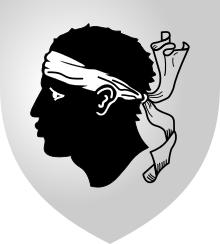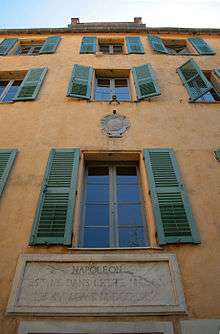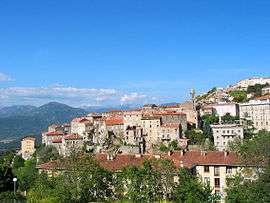Corse-du-Sud
Corse-du-Sud (French pronunciation: [kɔʁs.dy.syd]; Corsican: Corsica suttana [ˈkorsiɡa sutˈtana], Pumonti [puˈmɔ̃ti] or Pumonte [ˈpumɔ̃tɛ] also Italian: [ˈpumonte]; English: Southern Corsica) is still as of 2019 an administrative department of France consisting of the southern part of the island of Corsica. The corresponding departmental territorial collectivity merged with that of Haute-Corse on 1 January 2018, forming the single territorial collectivity of Corsica, coinciding with territorial elections[1] The people living in Corse-du-Sud are called "Southerners" (Suttanacci).
Corse-du-Sud (Southern Corsica) | |
|---|---|
 Coat of arms | |
 Location of Corse-du-Sud in France | |
| Coordinates: 41°51′N 9°2′E | |
| Country | France |
| Region | Corsica |
| Former prefecture | Ajaccio |
| Subprefectures | Sartène |
| Government | |
| • President of the Departemental Council | Jean-Pierre Luciani |
| Area | |
| • Total | 4,014 km2 (1,550 sq mi) |
| Population (2017) | |
| • Total | 157,249 |
| • Rank | 96th |
| • Density | 39/km2 (100/sq mi) |
| Time zone | UTC+1 (CET) |
| • Summer (DST) | UTC+2 (CEST) |
| Department number | 2A |
| Arrondissements | 2 |
| Cantons | 11 |
| Communes | 124 |
| ^1 French Land Register data, which exclude estuaries, and lakes, ponds, and glaciers larger than 1 km2 | |
History

The department was formed on 1 January 1976, when the single department of Corsica was divided into Haute-Corse and Corse-du-Sud. Its boundaries corresponded to the former department of Liamone, which existed from 1793 to 1811.
On 6 February 1998, Corse-du-Sud's prefect Claude Érignac was assassinated in Ajaccio. The Corsican nationalist Yvan Colonna was eventually convicted of the crime.
On 6 July 2003 a referendum rejected increased autonomy by a small majority, with 50.98 percent voting against and 49.02 percent for. This was a major setback for the French Minister of the Interior, Nicolas Sarkozy, who had hoped to use Corsica as the first step in his decentralization programme.
Politics
Current National Assembly representatives
| Constituency | Member[2] | Party | |
|---|---|---|---|
| Corse-du-Sud's 1st constituency | Jean-Jacques Ferrara | The Republicans | |
| Corse-du-Sud's 2nd constituency | Paul-André Colombani | Pè a Corsica | |
Geography
The department was surrounded on three sides by the Mediterranean Sea and on the north by the department of Haute-Corse. The entire island of Corsica is mountainous with many beautiful beaches.
Tourism
The former department enjoys the mild and hot climate of Mediterranean Islands, and therefore attracts a lot of tourists. Its perhaps largest tourist attraction is the city of Bonifacio, part of which is built upon a huge cliff. But inside mountains are beautiful as well, especially the Aiguilles de Bavella, some naked, needle-like rocks.

 Bonifacio citadel
Bonifacio citadel
 Stone bridge near Ota
Stone bridge near Ota
See also
References
- Morgane Rubetti (1 December 2017). "Corse : cinq questions pour comprendre les élections territoriales". Le Figaro. Retrieved 2 December 2017.
- http://www.assemblee-nationale.fr/
External links
- (in French) General Council website
- (in English) Corse-du-Sud at Curlie
- (in French) University of Corsica website